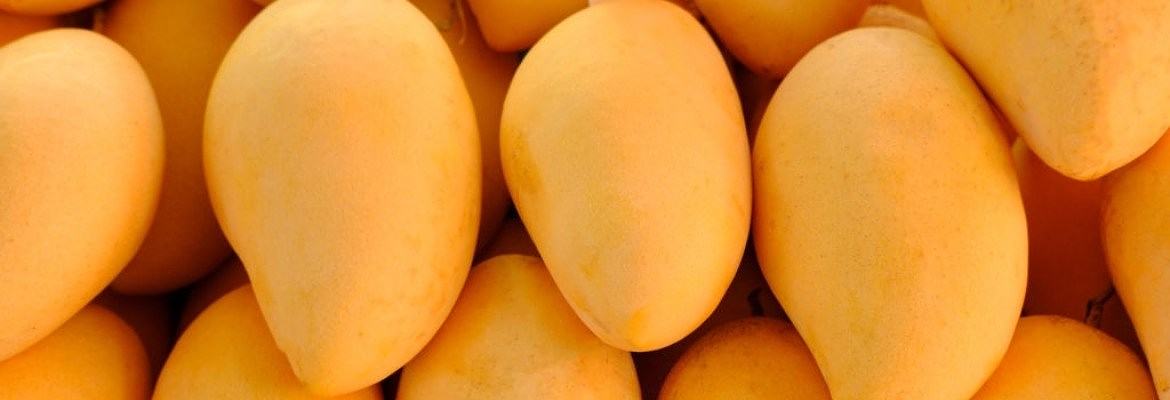Mango, sometimes also known as “The king of the fruits”, is a tropical drupe or a stone fruit. Mango is well known for its exquisite taste and amazing fragrance.
The mango fruit has leathery, smooth skin, and the shape can vary from long and slender to kidney-shaped or even somewhat round. Ripe mango flesh is sweet, very aromatic and juicy.
There are many varieties of mangoes and their size and weight can vary from variety to variety. Mango size can vary from 5-25 cm (2-10 inches) and mango weight can range from 150 – 2000 grams (0.33 – 4.4 pounds or 5.3 – 70.5 ounces).

Scientific name of Mango
Mangifera Indica
Other names of Mango
- Mangue
- Manga
- Aam
- Keri
Calories by source in Mango
- Calories by carbohydrate in Mango = 90%
- Calories by fat in Mango = 5%
- Calories by protein in Mango = 5%
Fats and Fatty Acid profile of Mango
- Polyunsaturated fat (PUFA) in Mango = 24%
- Saturated fat (SFA) in Mango = 30%
- Monounsaturated fat (MUFA) in Mango = 46%
Nutrition facts of Mango
*Serving size = 100 grams = 3.55 Ounces = 1/2 cup
*DV= % Daily Value (%DV indicates how much nutrients contribute to a person’s daily diet from a serving of a food. DV assists you in determining whether or not a serving of food is high or low in a particular nutrient.)
| Nutrient | Amount | Unit | DV |
|---|---|---|---|
| Calories | 60 | KCAL | |
| Fat | 0.38 | GRAM | 0% |
| Protein | 0.82 | GRAM | 2% |
| Carbohydrate | 14.98 | GRAM | 5% |
Detailed vitamin profile of Mango, vitamin A, vitamin B12, vitamin B6, vitamin C, vitamin D, Folate, Niacin, Thiamin, and Riboflavin is shown in the chart.
Detailed mineral profile of Mango, Sodium(Na), Calcium(Ca), Copper(Cu), Iron(Fe), Magnesium(Mg), Selenium(Se), Phosphorus(P), Potassium(K) and Zinc(Zn) is shown the chart.
Check freshness in Mango
- Ripe mangoes skin color depends on the variety of the mango ( yellow, green, red etc)
- Select a mango which is firm and gives in a little when pressed
- Depending on the variety of the mango the ripeness can be judged from the color around the stem. For example a yellow mango having green color near the stem is not fully ripped
- Avoid dented mangoes. Dented mangoes with very few brown patch is edible if the brown part is removed
- Unripe mangoes will be hard to the touch and will be sour in taste
- Unripe mangoes are green in color
- Mangoes will have natural sap covering which is released from the stem of the fruit when its harvested. it can easily be cleaned ans shall not be taken as sign of bad mango
- Judging the freshness of mango with the thickness of the skin varies in different varieties of the mango.
- Over ripe mangoes will be mushy to the touch
- Ripe mangoes will have pleasant fruity smell whereas unripe mangoes will not have a smell or may have sour sappy smell
Availability of Mango
- The Seasons of mango depend on the geographical location
- Generally available all round the year because of exports and imports of carious mangoes from all around the world
- India – Mango season ranges from February – April
- Indonesia – Mango season ranges from June – December
- Mexico – Mango season ranges from January – September
- Brazil – Mango season ranges from October – March
How to store Mango
- Ripe mangoes can be stored at room temperature for 2-3 days
- Ripe mangoes can be store in refrigerator for 4-5 days
- Unripe mangoes can be stored at room temperature for 3-4 days without losing flavor (dark and cool place is recommended)
- Sometimes depending on the growth phase, unripe mangoes might take 7 days to ripen
- Ripe mango pieces can be stored in refrigerated by 2-3 days
- Ripe mango pieces can be stored in the freezer in a zip lock airtight bag. As much air as possible should be removed from the bag and pieces should be spread evenly. frozen mango pieces can be stored for as long as 6 months
Complete nutrition facts of Mango
Click on the link HERE to download high quality, high resolution and print ready PDF version of the Mango nutrition chart/infographic.


